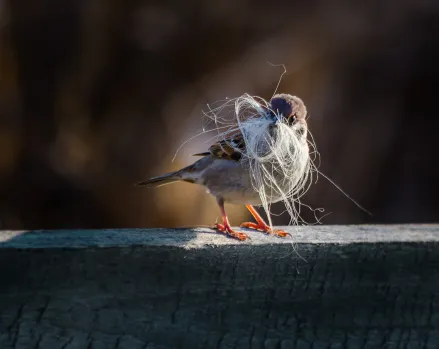Between my XXL kitty and my husky mix, it always seems to be shedding season at our house. If your house also has a bounty of scrap pet hair, you might be interested in how to repurpose that hair to benefit local nesting wildlife.
Birds that build nests, especially those that nest in trees, may construct a new nest or reuse one either built by them or another bird. Sticks and twigs provide the framework for the nest but they also incorporate smaller bits of woody material, grass and moss to fill in the gaps, insulate it and make it more cozy. Although chances are that there is likely no shortage of this softer material, there is definitely no shortage of pet hair tumbleweeds at my house. Western bluebirds, European starlings and wrens are just a few of the species that love to use pet hair to line their nests but other birds such as American robins weave it into the structure of their nests as well. Tree squirrels also build nests (called dreys) and have been known to collect animal fiber to line their twig and leaf nests.
Dog and cat hair works well as nesting material because it is durable and repels water. The texture of pet hair makes it easy for some species to weave into their nest while others prefer to line the inside of the nest with it making it soft and comfortable; after all momma and babies will be spending quite a lot of time there. The animal hair has insulating properties that help maintain a consistent temperature for the eggs and nestlings as well as helping the birds to regulate their own body temperature. Some research has shown that the pet hair also contains pheromones that help the parents identify their nest as well as deter pests which aids in the overall health and welfare of the birds using it.
Sharing your pet’s bounty is easy and doesn’t require anything other than a good brushing. If you happen to have an empty suet feeder you can use that by filling the cage with hair and hanging it in a tree or bush. If you don’t have a wire cage, you can simply place wads of hair high in shrubs, near feeders or anywhere the birds will see it. You can even use a wire whisk if you have one; just stuff hair inside the whisk and hang it upside down by its handle. Just make sure it’s pest free and that there are no chemicals, topical flea and tick medication or grooming products as those can harm the species that may collect the hair.
Since there’s no end to the boundless gift of hair from your pets, offering it to backyard wildlife is a great way to repurpose something that most likely ends up in the trash can for most of us. By sharing your pets castoffs, you may be helping local birds nesting success.
Fun fact: Some birds like the animal fiber so much that they’ll steal it from sleeping wildlife such as foxes and raccoons or dive bomb dogs, cats and even people for a beakfull of hair. Recently scientists gave this risky behavior a name: kleptotricky which literally translates as “to steal hair”!







